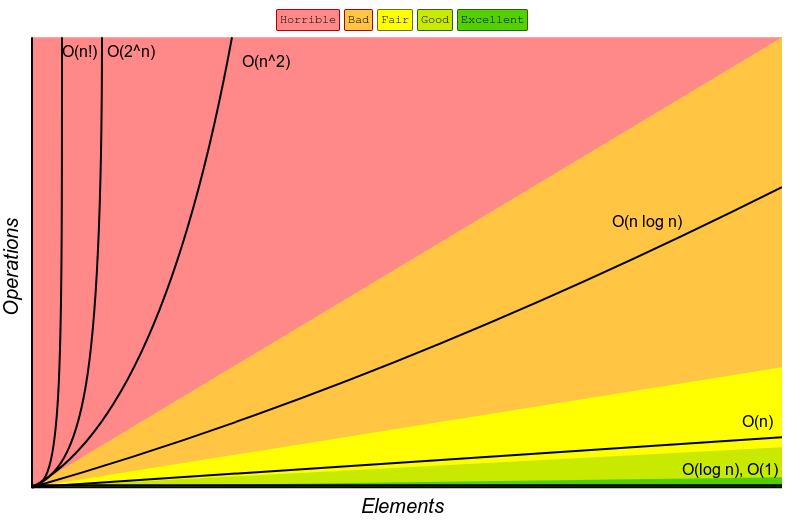reading-notes
Linked Lists And Big O Of N
Big O notation
Big O notation is used to describe the efficiency of an algorithm or function. This efficiency depends on two factors:
- the amount of time the program needs to execute
- the memory that it takes to store data in .
Important point to understand the big O notation:
-
Input Size:
the size of the parameter that enters the function.
-
Units of Measurement: and these units divide into:
- Measurements of time:
- The time in milliseconds: the time the code needs to give the output
- The number of operations that are executed, the less the better, especially for loops
- The number of “Basic Operations” that are executed: for example, loops take the most time
- Measurements of space:
- The amount of space needed to hold the code for the algorithm
- The amount of space needed to hold the input data
- The amount of space needed for the output data.
- The amount of space needed to hold working space during the calculation.
Orders of Growth
- O(1)
it describes the case when code will executes in the same time and space no matter what’s the inputs (constant), example:
def fact2(n):
if n == 0:
return 1
else:
return n * fact2(n-1)
print (fact2(5))
- O(N)
O(N) describes an algorithm whose performance will grow linearly and in direct proportion to the size of the input data set. for example:
def fact(n):
product = 1
for i in range(n):
product = product * (i+1)
return product
print (fact(5))
- O(N²)
O(N²) represents an algorithm whose performance is directly proportional to the square of the size of the input data set. example:
a = [1, 2, 3, 4, 5, 6, 7, 8, 9, 10]
for i in a:
for x in a:
print("x")
- O(2^N)
O(2^N) denotes an algorithm whose growth doubles with each addition to the input data set. Example
int Fibonacci(int number)
{
if (number <= 1) return number;
return Fibonacci(number - 2) + Fibonacci(number - 1); `}`
Logarithms
This type of algorithm is described as O(log N). The iterative halving of data sets described in the binary search example produces a growth curve that peaks at the beginning and slowly flattens out as the size of the data sets increase

Linked Lists
A linked list is a sequence of data elements, which are connected together via links. Each data element contains a connection to another data element in form of a pointer.
Traversal Linked List
Traversing is the most common operation that is performed in almost every scenario of singly linked list. Traversing means visiting each node of the list once in order to perform some operation on that.
The pseudo-code for checking if the linked list includes a specific value is as so:
ALGORITHM Includes (value)
// INPUT <-- integer value
// OUTPUT <-- boolean
Current <-- Head
WHILE Current is not NULL
IF Current.Value is equal to value
return TRUE
Current <-- Current.Next
return FALSE
verifying big o of traversal:
-
The Big O of time for Includes would be O(n).
-
The Big O of space for Includes would be O(1).
Adding a Node
Here are the required steps to add a new node with an O(1) efficiency:
- instantiate the new node that we are adding (use Add() method)
- newNode.Next by default is set to null. We want to set newNode.Next property to the same location that the Head node is pointing towards.
- At this point in the program we now “technically” have newNode at the beginning of the linked list
creation of a linked list in Python:
Example:
class Node:
def __init__(self, dataval=None):
self.dataval = dataval
self.nextval = None
class SLinkedList:
def __init__(self):
self.headval = None
list1 = SLinkedList()
list1.headval = Node("Mon")
e2 = Node("Tue")
e3 = Node("Wed")
#Link first Node to second node
list1.headval.nextval = e2
#Link second Node to third node
e2.nextval = e3
to summarize the parts of the linked list in an image:

Memory management
The biggest differentiator between arrays and linked lists is the way that they use memory in our machines.
-
arrays -> When an array is created, it needs a certain amount of memory. If we had 7 letters that we needed to store in an array, we would need 7 bytes of memory to represent that array.
-
Linked List -> when a linked list is born, it doesn’t need 7 bytes of memory all in one place. One byte could live somewhere, while the next byte could be stored in another place in memory altogether! Linked lists don’t need to take up a single block of memory
